Figure from US patent 9,703,939 for a method of securely unlocking (accessing) a mobile phone using the phone’s camera and face recognition.

1964
FACE RECOGNITION

Face recognition systems attempt to identify people from images or video footage, often by comparing facial features (e.g., relative position of the eyes and nose) with those in an image database. Some modern systems use 3-D sensors to capture information and to increase accuracy when confronted with variations in lighting and viewing angles, and certain smartphones use infrared light to illuminate a user’s face during the authentication process. Many challenges exist for accurate face recognition, such as when people are wearing accessories like hats and sunglasses, or even makeup, but today, in some circumstances, algorithms outperform humans in recognizing faces. The origin of face recognition “technology” could be traced to nineteenth-century England, where a regular system of prison photography was introduced in 1852, as a more humane method than branding, to keep track of prisoners and to share with other police departments when they escaped. One of the pioneers of more advanced face recognition was mathematician and computer scientist Woody Bledsoe (1921–1995), who worked on earlier forms of face recognition in 1964. At the time, he noted that the task was particularly difficult due to head rotation and tilt, lighting, facial expression, age, etc. Bledsoe and other early pioneers tended to rely on significant human collaboration with the computer, as humans manually extracted image facial coordinates from photos by hand using a graphics tablet (e.g., drawing pad).
Over the years, face recognition systems have employed a variety of techniques, including eigenfaces, hidden Markov models, and dynamic link matching. As outlined by technologist Jesse Davis West, face recognition has several important applications today: “Law enforcement agencies are using face recognition to keep communities safer. Retailers are preventing crime and violence. Airports are improving travelers’ convenience and security. And mobile phone companies are using face recognition to provide consumers with new layers of biometric security.” Nevertheless, one may wonder if this could mark a worrisome turning point in civilization, when people are no longer able to go out in public and remain anonymous.
SEE ALSO Optical Character Recognition (OCR) (1913), Speech Recognition (1952), AIBO Robot (1999)